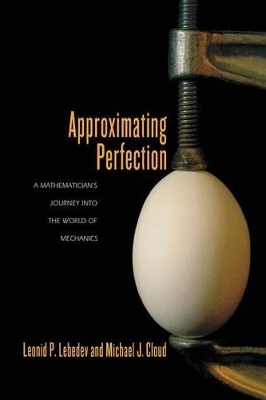
Approximating Perfection
Princeton University Press (Verlag)
978-0-691-16826-5 (ISBN)
- Lieferbar (Termin unbekannt)
- Versandkostenfrei
- Auch auf Rechnung
- Artikel merken
Leonid P. Lebedev is Professor of Mathematics at the National University of Colombia and Professor of Mechanics and Mathematics at Rostov State University in Russia. He is the author of Functional Analysis in Mechanics and Functional Analysis: Applications in Mechanics and Inverse Problems. Michael J. Cloud is Professor of Electrical and Computer Engineering at Lawrence Technological University. He is the author of Inequalities with Applications to Engineering and Electromagnetics. Lebedev and Cloud also coauthored Tensor Analysis, and The Calculus of Variations and Functional Analysis with Optimal Control and Applications in Mechanics.
Preface vii Chapter 1. The Tools of Calculus 1 1.1 Is Mathematical Proof Necessary? 2 1.2 Abstraction, Understanding, Infinity 6 1.3 Irrational Numbers 8 1.4 What Is a Limit? 11 1.5 Series 15 1.6 Function Continuity 19 1.7 How to Measure Length 21 1.8 Antiderivatives 33 1.9 Definite Integral 35 1.10 The Length of a Curve 42 1.11 Multidimensional Integrals 44 1.12 Approximate Integration 47 1.13 On the Notion of a Function 52 1.14 Differential Equations 53 1.15 Optimization 59 1.16 Petroleum Exploration and Recovery 61 1.17 Complex Variables 63 1.18 Moving On 65 Chapter 2. The Mechanics of Continua 67 2.1 Why Do Ships Float? 67 2.2 The Main Notions of Classical Mechanics 71 2.3 Forces, Vectors, and Objectivity 74 2.4 More on Forces; Statics 76 2.5 Hooke's Law 80 2.6 Bending of a Beam 84 2.7 Stress Tensor 94 2.8 Principal Axes and Invariants of the Stress Tensor 100 2.9 On the Continuum Model and Limit Passages 102 2.10 Equilibrium Equations 104 2.11 The Strain Tensor 108 2.12 Generalized Hooke's Law 113 2.13 Constitutive Laws 114 2.14 Boundary Value Problems 115 2.15 Setup of Boundary Value Problems of Elasticity 118 2.16 Existence and Uniqueness of Solution 120 2.17 Energy; Minimal Principle for a Spring 126 2.18 Energy in Linear Elasticity 128 2.19 Dynamic Problems of Elasticity 132 2.20 Oscillations of a String 134 2.21 Lagrangian and Eulerian Descriptions of Continuum Media 137 2.22 The Equations of Hydrodynamics 140 2.23 D'Alembert-Euler Equation of Continuity 142 2.24 Some Other Models of Hydrodynamics 144 2.25 Equilibrium of an Ideal Incompressible Liquid 145 2.26 Force on an Obstacle 148 Chapter 3. Elements of the Strength of Materials 151 3.1 What Are the Problems of the Strength of Materials? 151 3.2 Hooke's Law Revisited 152 3.3 Objectiveness of Quantities in Mechanics Revisited 157 3.4 Plane Elasticity 159 3.5 Saint-Venant's Principle 161 3.6 Stress Concentration 163 3.7 Linearity vs. Nonlinearity 165 3.8 Dislocations, Plasticity, Creep, and Fatigue 166 3.9 Heat Transfer 172 3.10 Thermoelasticity 175 3.11 Thermal Expansion 177 3.12 A Few Words on the History of Thermodynamics 178 3.13 Thermodynamics of an Ideal Gas 180 3.14 Thermodynamics of a Linearly Elastic Rod 182 3.15 Stability 186 3.16 Static Stability of a Straight Beam 188 3.17 Dynamical Tools for Studying Stability 193 3.18 Additional Remarks on Stability 195 3.19 Leak Prevention 198 Chapter 4. Some Questions of Modeling in the Natural Sciences 201 4.1 Modeling and Simulation 201 4.2 Computerization and Modeling 203 4.3 Numerical Methods and Modeling in Mechanics 206 4.4 Complexity in the Real World 208 4.5 The Role of the Cosine in Everyday Measurements 209 4.6 Accuracy and Precision 211 4.7 How Trees Stand Up against the Wind 213 4.8 Why King Kong Cannot Be as Terrible as in the Movies 216 Afterword 219 Recommended Reading 221 Index 223
| Zusatzinfo | 35 line illus. |
|---|---|
| Verlagsort | New Jersey |
| Sprache | englisch |
| Maße | 152 x 235 mm |
| Gewicht | 312 g |
| Themenwelt | Mathematik / Informatik ► Mathematik ► Angewandte Mathematik |
| Technik ► Maschinenbau | |
| ISBN-10 | 0-691-16826-1 / 0691168261 |
| ISBN-13 | 978-0-691-16826-5 / 9780691168265 |
| Zustand | Neuware |
| Haben Sie eine Frage zum Produkt? |
aus dem Bereich


